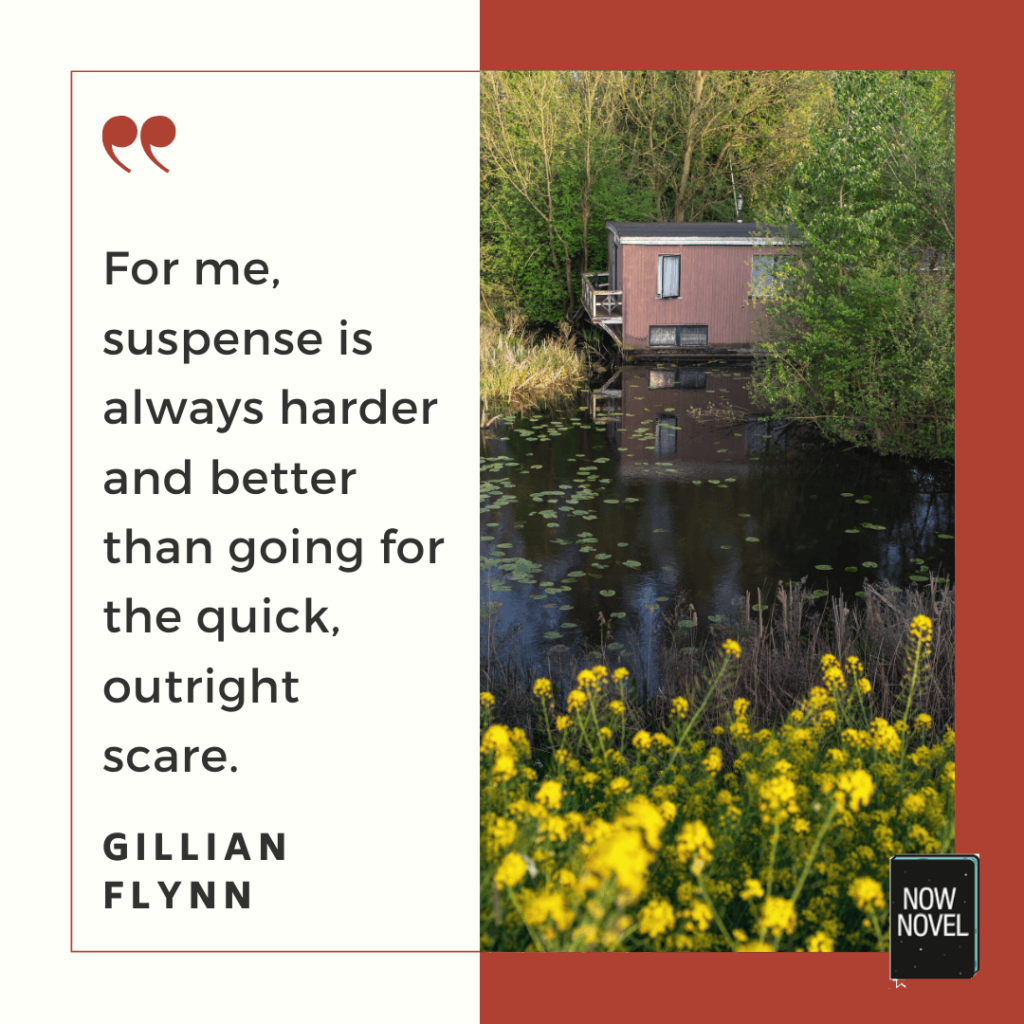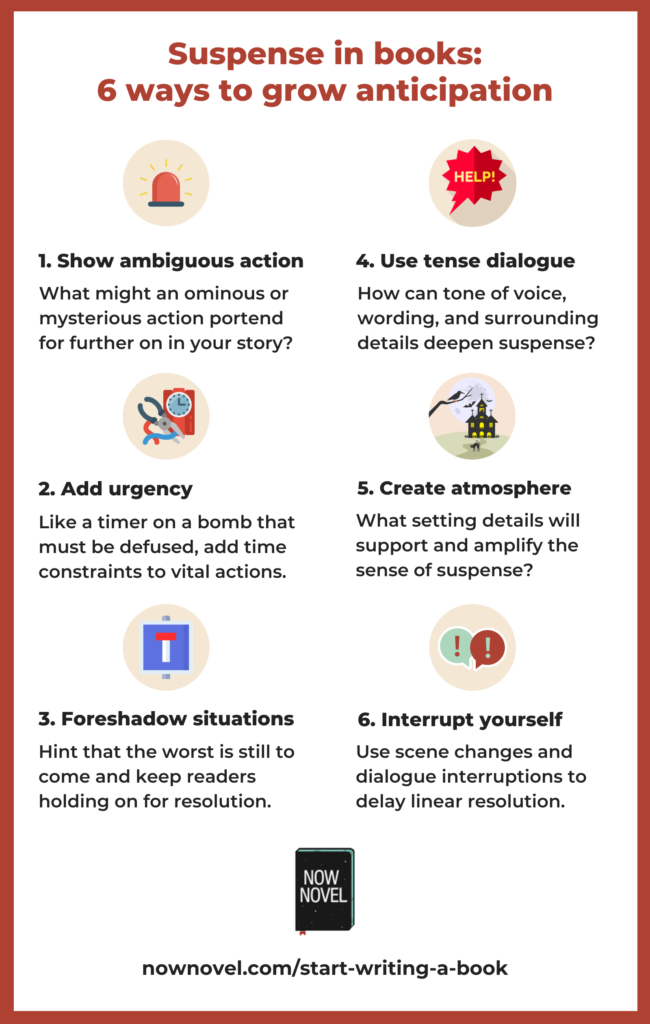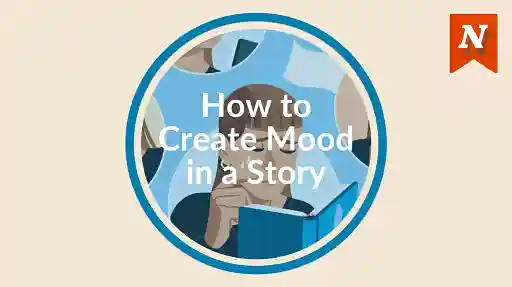Suspense in books is essential if you want to keep reader's rapt with anticipation, whatever your genre. How can you give readers that tightrope-walking feeling? Try these 6 suspense builders:
How to build suspense in books:
- Show ambiguous action
- Add urgency
- Foreshadow uneasy situations
- Use tense dialogue
- Create suspenseful atmosphere
- Interrupt yourself
Let's explore these ideas on how to create narrative suspense further, with examples:
1. Show ambiguous action
Showing ambiguous action - action that could have multiple possible meanings or implications - is one way to build suspense in books.
Take a simple scenario: A man is waiting at a border post. How do we know he's waiting? He's anxiously pacing, checking his watch, while staring down a deserted approaching road.
The waiting, the pacing, the time-checking - these are actions that are mildly ambiguous. They clearly indicate a person who is under pressure for time and anxious, yet until we see, for example, a patrol-car approaching, we don't know why.
John Le Carré, a master of building suspense in stories, uses this situation in the opening to his classic Cold War spy novel, The Spy who Came in from the Cold:
The American handed Leamas another cup of coffee and said, "Why don't you go back and sleep? We can ring you if he shows up."
John le Carré, The Spy who Came in from the Cold (1963), p. 3
Leamas said nothing, just stared through the window of the checkpoint, along the empty street.
"You can't wait forever, sir. Maybe he'll come some other time. We can have
the Polizei contact the Agency: you can be back here in twenty minutes."
"No," said Leamas, "it's nearly dark now."
In Leamas' waiting for a mysterious contact, Carré creates ambiguity on many fronts:
- Why is Leamas waiting anxiously into the night?
- Who is Leamas, or 'the Agency', for that matter?
2. Add urgency
In a tense scenario, urgency helps to build suspense. Archeologists realize the site they're excavating is close to collapse and they have minutes to evacuate it. A detective needs to find a killer before he strikes again.
Time-based pressures add suspense in everything from murder mysteries and crime thrillers to sports stories where athletes have to beat records in fractions of seconds for glory.
In the 1968 film adaptation of Ian Fleming's James Bond novel Goldfinger, writers upped the suspense. In the original, the villain plans to steal the United States' gold reserves. For the screen version, Goldfinger plans to contaminate them with a 'dirty' atomic bomb. Bond is handcuffed to the bomb, and proves unable to defuse it. But an atomic specialist arrives just in time, defusing the bomb with 7 seconds to spare.
This use of suspense may be campy and trope-y (which is part of Bond films' appeal). Yet it effectively puts pressure on the hero's progress while also showing the limits of his capabilities, a vulnerability that adds narrative suspense in itself.
3. Foreshadow uneasy situations
You can use narrative foreshadowing to build suspense, too. For example:
'It was only the following week that I discovered just how bad it would get.'
Or:
'If I thought then that it was the worst summer I'd ever have, I was badly mistaken.'
Foreshadowing unsavory situations is an effective way to make readers curious about what will happen next. Remember:
- Avoid excessive repetition: Ending every chapter with an ominous statement will make the attempt to create suspense transparent
- Avoid revealing too much about the impending situation: Mystery is a core element of suspense

4. Use tense dialogue
Dialogue often adds suspense in books. From terse interrogations in police procedurals to lovers' spats in romance.
For one, a speaking voice can be mysterious in many ways. You might, for example, begin a scene with dialogue without revealing the identity of the speakers. For example:
"Hurry!" the first man snapped.
"I'm going as f- ... SHIT!' the other yelled, tripping over a loose paving stone in the dark and letting go of his side. The first man staggered forward, nearly dropping and shattering the delicate object of their mission.
The urgency in this dialogue, paired with the mystery (what the men are carrying, why they're doing this in the dark) both help to add suspense.
The first man's irritability and the inference that the item they're carrying is fragile further adds suspense, because there are stakes to the action, too.
The first example from Le Carré's spy novel also shows how to create suspense using dialogue. You can build suspense by:
- Only partially revealing the identity of the speakers
- Partially revealing the object or purpose of their conversation
- Adding urgency, tension or other elements of suspense (such as foreshadowing a possibly unpleasant outcome, making your reader wait to see what will happen)
5. Create suspenseful atmosphere
There are many ways atmosphere adds suspense. If you've seen Ari Aster's horror movies such as Hereditary, for example, you will know how the director creates terror foreboding atmosphere as much as creepy event.
Suspense in books builds when the author shows us mysterious or foreboding signs.
The director David Lynch is a master of this. As an example, between tense scenes in his cult series Twin Peaks he might cut to a lone shot of a traffic light in the dark night sky as its lights change from green, to yellow, to red. The association of being stopped at night, in a setting already established as mysteriously dangerous (the town of Twin Peaks), creates further ominous atmosphere, upping the suspense.
In another scene, the camera is set up behind a record player as it films characters, creating the sense that they're being watched. Or it lingers on a ceiling fan, creating suspense. We wonder 'why is this object significant?' or 'what's happening elsewhere out of this frame?' as a character frantically searches for her daughter.
In older slasher or whodunnit films, a common shot in a murder scene is for the camera to linger on an inert object which is suddenly sprayed with blood while the murder occurs out of frame (particularly before the identity of the killer is revealed). These are all ways in which objects around the key actors in a scene can add suspense, too.
As an exercise, describe a setting in a paragraph to create each of the following:
- A strong sense of urgency - of something needing to happen in the next 5 minutes
- An object that is out of place or altered from its usual state in a way that implies something ominous, dangerous or dramatic has happened or will soon happen

6. Interrupt yourself
Suspense in books works at multiple levels. On the one hand, there is narrative suspense. In this type of suspense, we wonder what will happen next. Or we wait anxiously for result B to follow action A.
To build narrative suspense in books, subvert the reader's expectations about what will happen next. Interrupting the flow of a tense scene, for example, just before a hero reaches their object, to show other, related processes underway (an antagonist closing in), delays resolution.
This is a classic device in series, in both books and TV, where primary story arcs are drawn in longer sequences while individual episodes have their own build-ups and climaxes.
Interruption is also useful within individual scenes. For example, in the above example describing two thieves carrying a fragile object into the night, the man's retort is interrupted by his swearing when he trips. This moment of interruption makes suspense flare up in an instant.
Need help making your story more suspenseful? Get a no-obligation quote for a manuscript evaluation now.








